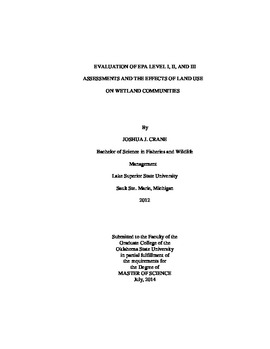| dc.contributor.advisor | Dzialowski, Andrew R. | |
| dc.contributor.author | Crane, Joshua Jermond | |
| dc.date.accessioned | 2015-06-17T20:05:24Z | |
| dc.date.available | 2015-06-17T20:05:24Z | |
| dc.date.issued | 2014-07-01 | |
| dc.identifier.uri | https://hdl.handle.net/11244/14785 | |
| dc.description.abstract | Effective tools are needed to monitor and assess wetland ecosystems. The U.S. Environmental Protection Agency (EPA) proposed a three level framework that includes landscape assessments (Level I), rapid assessments (Level II), and intensive surveys of wetland communities (Level III). The EPA conducted a national wetland condition assessment in 2011 using a new rapid assessment method (USA-RAM) that was not calibrated to specific regions. The objectives of this study were to compare the relationships between USA-RAM to the Level I and III assessments, analyze the influence of spatial scale on Level I analysis, and determine whether within-wetland or landscape features were more important in structuring macroinvertebrate communities. Plant communities from 22 wetlands of varying levels of landscape disturbance were surveyed in 2012 and 2013 and macroinvertebrate communities were surveyed twice in the 2013. Each wetland was assessed using USA-RAM. I analyzed land use in the buffer surrounding each wetland using the 2012 CropScape dataset at four spatial scales (100m, 300m, 500m, and 1000m). I found significant relationships between Level I assessments (e.g., the Landscape Development Intensity index) and the Level II assessment (USA-RAM) with the strongest relationships occurring within the 100m buffer around the wetlands. This is an important finding suggesting that computer assessments of the buffer can be used to predict stressors to wetlands. However, there were no significant relationships between the Level I and either the Level II (USA-RAM) or the Level III (plant and macroinvertebrate) assessments. Canonical Correlation Analysis (CCA) showed that land use within the 100m buffer explained the most variation among plant communities, while the 300m buffer explained the most variation among the aquatic insect genera. Land use explained more of the variation in aquatic insect genera than within-wetland variables, showing that even relatively less mobile and smaller taxa (as compared to waterfowl or muskrats) are affected by land use disturbances. Combined, my results suggest that land use can predict wetland disturbance as measured by the USA-RAM, but the USA-RAM does not correspond to wetland community condition; therefore the USA-RAM needs to be calibrated and potentially modified to accurately assess wetland community condition in the region. | |
| dc.format | application/pdf | |
| dc.language | en_US | |
| dc.publisher | Oklahoma State University | |
| dc.rights | Copyright is held by the author who has granted the Oklahoma State University Library the non-exclusive right to share this material in its institutional repository. Contact Digital Library Services at lib-dls@okstate.edu or 405-744-9161 for the permission policy on the use, reproduction or distribution of this material. | |
| dc.title | Evaluation of Epa Levels I, Ii, and Iii Assessments and the Effects of Land Use on Wetland Communities | |
| dc.type | text | |
| dc.contributor.committeeMember | Davis, Craig A. | |
| dc.contributor.committeeMember | Papes, Monica | |
| osu.filename | Crane_okstate_0664M_13556.pdf | |
| osu.accesstype | Open Access | |
| dc.description.department | Zoology | |
| dc.type.genre | Thesis | |
| dc.subject.keywords | land use | |
| dc.subject.keywords | macroinvertebrates | |
| dc.subject.keywords | oklahoma | |
| dc.subject.keywords | usa-ram | |
| dc.subject.keywords | wetlands | |
